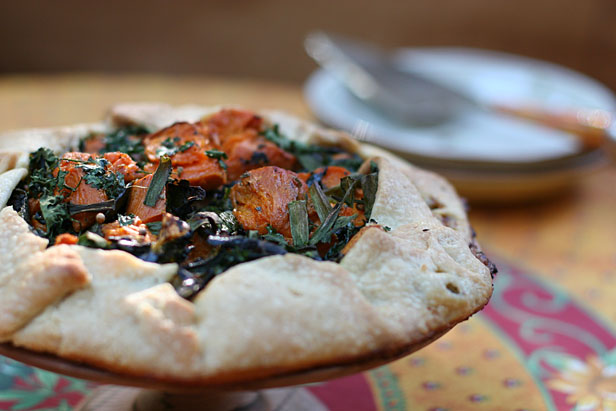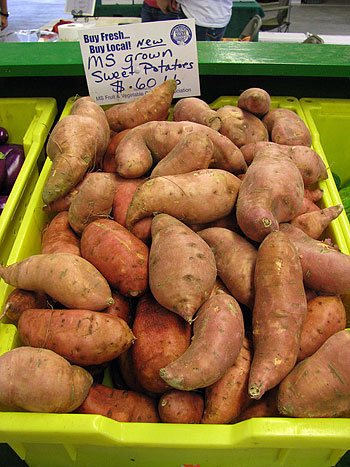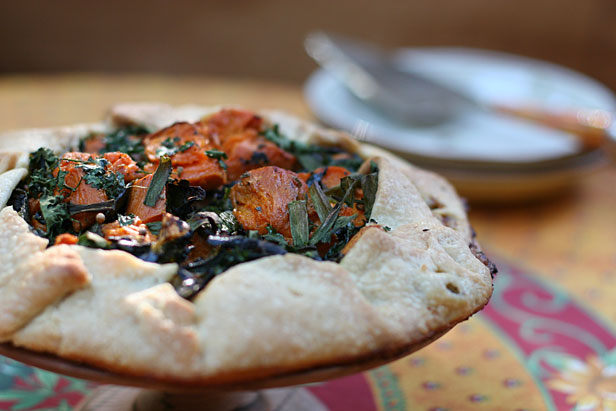 Sweet, tart: Heirloom sweet potatoes stand up to poblano peppers nicely.Photo: April McGreger
Sweet, tart: Heirloom sweet potatoes stand up to poblano peppers nicely.Photo: April McGreger
 Tubery good: Sweet potatoes at a Jackson, Miss. farmers market.Photo: Natalie MaynorI’ve been called the patron saint of the sweet potato. I was born in the self-proclaimed “Sweet Potato Capital” of America, where every other family is in the business of sweet potato farming and the most exciting thing all year is the Sweet Potato Festival. My first job was working in the sweet potato fields, and sweet potatoes were as common on my family’s dinner table as potatoes are in the Midwest.
Tubery good: Sweet potatoes at a Jackson, Miss. farmers market.Photo: Natalie MaynorI’ve been called the patron saint of the sweet potato. I was born in the self-proclaimed “Sweet Potato Capital” of America, where every other family is in the business of sweet potato farming and the most exciting thing all year is the Sweet Potato Festival. My first job was working in the sweet potato fields, and sweet potatoes were as common on my family’s dinner table as potatoes are in the Midwest.
To me, the sweet potato is a very misunderstood vegetable, too often overshadowed in fall by the pumpkin and unfairly compared to the unrelated potato. Most people only think of the sweet potato between Halloween and Christmas, and then far too often as the clichéd marshmallow-topped casserole or pie. Any praise it gets is more often than not erroneously bestowed on the yam, which is simply a variety of sweet potato that Louisiana State University’s Ag Center began marketing as a sweeter, moister sweet potato in the 1930s. (True yams are large, starchy, bland tubers — sweet potatoes are roots — rarely seen outside of ethnic markets in the U.S.)
Completely unadorned, the sweet potato has enough natural sugars to satisfy any sweet tooth, and without the common adulteration, it offers generous nutritional benefits, with lots of complex carbohydrates and high fiber, vitamin C, B6, calcium, protein, and iron content. The vibrant orange-fleshed varieties provide healthy doses of beta-carotene (an immunity-boosting nutrient and precursor to vitamin A) as well.
Sweet potatoes come in a wide variety of colors, both inside and out, with varying textures, flavor notes, and degrees of sweetness. In recent years I’ve been happily exploring the less common, often heirloom varieties of sweet potato that have recently surfaced at my local farmers market. My favorite is the Mahon, or Bradshaw as it is sometimes called, which tastes of distinctly of butterscotch. I also like the All Purple, which is just that — vibrant purple inside and out — with a much drier, starchier texture than most sweet potatoes. It’s a great variety for making sweet potato fries, which brings me to the sweet potato’s amazing versatility.
Some of the easiest recipes for savory and healthy sweet potato sides involve little more than cutting up the sweet potato along with a little onion, or shallots, tossing it in olive oil, salt, pepper, and roasting at 400 degrees until tender, stirring occasionally to prevent burning. I like to chop up a bunch of mustard greens or kale and toss that with salt and pepper to add to the dish in the last 15 minutes of cooking.
But perhaps most of all I love to make savory sweet potato pies and tarts. Their texture is so lovely against a crispy, buttery crust, and the sweetness plays well against smoky, spicy, salty, and bright flavors. One of my favorite combinations is roasted sweet potato with olives, onions, feta, and harissa; or combining it with roasted peppers as I have done in the recipe below.
However, these are just suggestions. Your options for savory sweet potato pie are endless. Let your imagination and what’s available at your market guide you.
Savory Sweet Potato & Poblano Rustic Tart
If you don’t feel like making the pie crust, skip it. This dish would be great as a composed roasted sweet potato dish or cooked as a gratin or casserole. You could even bind the ingredients together with a custard as sort of a crustless quiche.
Makes one 9-inch pie
9-inch uncooked pie crust (recipe), rolled into a 10-inch diameter circle and refrigerated
3 medium sweet potatoes
3 to 4 medium poblano or Anaheim peppers (or substitute 1 tablespoon chopped canned chipotle peppers)
4 whole shallots or 2 small white onions, quartered
1/2 cup Mexican crema, or sour cream
1/3 cup chopped cilantro
2 tablespoons chopped green onions
a pinch of Mexican oregano
a pinch of cumin seeds
salt and pepper
wedge of lime
Wash the sweet potatoes well, pat dry, and prick with a fork several times. Place on a baking pan with the shallots or onions. Drizzle the shallots or onions with a little olive oil and sprinkle with salt and pepper.
Roast at 400 degrees F until the sweet potatoes are very tender and beginning to caramelize. If the onions begin to burn before the sweet potatoes are done, remove them from the baking tray and set aside.
Cool cooked sweet potatoes completely.
When cool, slip the skins off the sweet potatoes and cut into rough 2-inch chunks. (This step can be done up to several days in advance.)
If you have a gas stove, roast the poblano peppers over direct flame until blistered and blackened all over. Otherwise, you can broil them until they begin to blister. Place in a paper bag or wrap in foil and set aside to cool. When cool, rub most of the charred skin off the peppers, deseed them, and — with your fingers, if your peppers aren’t of the hot variety — tear the peppers into strips. Set aside.
When your vegetables are cool, remove your pie crust from the refrigerator. Roll out and be sure to patch any holes. Drape your circle of dough over your rolling pin and transfer to a pizza pan or baking sheet if not already on one.
Spread the bottom of the crust with the crema or sour cream, leaving a 2-inch border around the outside of the crust.
Next, spread the sweet potato chunks, the onions or shallots and the pepper strips over the crema. Sprinkle with salt and pepper, cumin, oregano, the cilantro and the green onions.
Fold the edge of the dough up over the top of the filling, pleating the dough as you work your way around the circle. Place the tart in the freezer for 10-15 minutes to firm up while you preheat the oven to 400 degrees F.
Bake the tart for 45 minutes or until the crust is dark golden brown. Remove from the oven, squeeze the lime wedge over the filling and allow to cool for 15 minutes before serving.
Serve warm or at room temperature.




